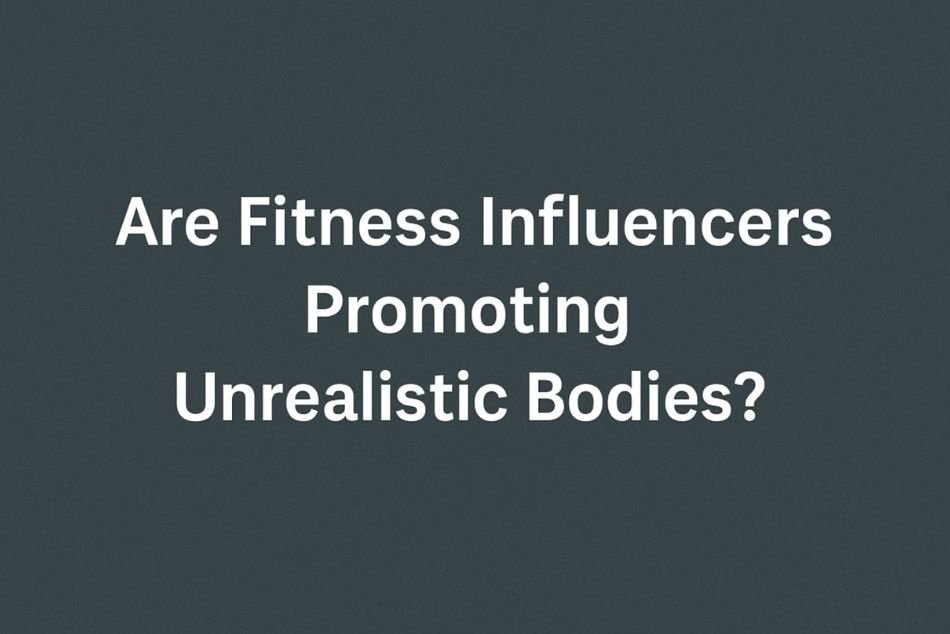Filtered Reality: Are Fitness Influencers Promoting Unrealistic Bodies Online?
Scroll through Instagram or YouTube, and you’ll see it everywhere — shredded abs, round glutes, chiseled jaws, and perfectly lit gym selfies. It’s inspiring at first, but after a while, it can start to feel exhausting. The question many people are quietly asking is simple: are fitness influencers promoting unrealistic bodies?
It’s not about calling anyone out or denying the hard work that goes into sculpting a great physique. It’s about understanding whether what we see online represents genuine fitness or a filtered illusion. The difference matters because millions of people are chasing these images daily — often without realizing how curated, enhanced, or simply unsustainable many of these physiques are.
Why Fitness Influencers Often Promote Unrealistic Bodies
To understand why this happens, it helps to look at how the fitness influencer economy works. Like any business built on social media, attention is currency. The more likes, comments, and followers someone has, the more opportunities they get for sponsorships, brand deals, and paid partnerships.

And attention, unfortunately, doesn’t always reward honesty. Perfect bodies get noticed. Extreme transformations go viral. Subtle, realistic progress — the kind that takes time and patience — doesn’t perform as well online.
So, to stay relevant, many influencers feel pressure to look their best 24/7. They learn every trick in the book — from lighting and angles to filters and post-editing — to keep up appearances. Some might maintain extremely low body fat levels year-round, something that’s physically and hormonally stressful. Others may use enhancement methods they never mention.
It’s not always malicious. Often, they start with good intentions but get trapped by audience expectations. When followers expect perfection, it’s hard to show the reality behind the scenes — the fatigue, the hunger, or the off-season weight fluctuations. In that sense, many influencers are also victims of the same system they feed.
What “Unrealistic Bodies” Really Mean in Fitness Culture
The phrase “unrealistic body” doesn’t mean a body that’s impossible to achieve — it means one that’s unsustainable for most people in the long term. The kind of physique often seen online is the result of strict dieting, meticulous training, ideal genetics, and sometimes professional photography or editing.
For example, many male influencers showcase physiques with visible abs and razor-sharp definition that typically require maintaining body fat levels around 6–9%. For most men, that’s far below what’s healthy year-round. Similarly, female influencers often display a combination of low body fat with visible curves — something that’s largely genetic and not always achievable through training alone.
Another issue is the narrow range of what’s portrayed as “fit.” Fitness isn’t supposed to look just one way. Strength, endurance, flexibility, and health can take countless forms, but social media often promotes a single aesthetic ideal. This creates a false standard that fitness equals a particular body type rather than a lifestyle or ability level.
When followers compare themselves to those curated bodies, they’re not just comparing against hard work — they’re comparing against lighting, timing, filters, and selective posting. That’s why so many people end up chasing an image that isn’t real life.
The Real-World Impact on Followers
The effects of these unrealistic portrayals go far beyond self-doubt. They affect how people train, eat, and think about themselves.
Physically, many followers push their bodies too hard, too fast. They adopt extreme diets, try “fat-burning” supplements, or overtrain without proper recovery. Instead of progress, they hit burnout, hormonal issues, or injury.
Mentally, the cost is even higher. Constant exposure to perfect physiques can distort body image and create feelings of inadequacy. Research has shown strong links between social media use and body dissatisfaction, especially among young adults. Some develop disordered eating habits or body dysmorphia — where even healthy, strong individuals feel they’re “never lean enough.”
There’s also a growing sense of discouragement. When progress doesn’t match what they see online, many people simply give up. They assume fitness isn’t “for them” because their results look ordinary. But the truth is, ordinary results are exactly what sustainable fitness looks like.
The social pressure extends to spending habits too. Followers invest in overpriced supplements, detox programs, or coaching plans, believing those will deliver the influencer’s body. When it doesn’t happen, they feel like failures — when in reality, they were chasing an edited version of success.
How to Recognize Unrealistic or Misleading Fitness Content
If you want to stay inspired without getting misled, learn to spot when a post or influencer might be stretching the truth. Here are some red flags:
1. “Too good to be true” transformations. If someone claims to go from average to shredded in a few weeks, it’s probably staged, manipulated, or highly selective.
2. Lack of transparency. Real coaches talk about genetics, consistency, rest, and nutrition. Unrealistic influencers skip the boring details and sell shortcuts.
3. One-size-fits-all programs. If every follower supposedly gets the same plan and results, it’s marketing, not coaching.
4. Over-reliance on supplements or gimmicks. When every other post is about a new fat burner, pre-workout, or protein bar, it’s a sales pitch.
5. No off-days. Everyone has times when they’re tired, bloated, or demotivated. If someone looks stage-ready every single day, either they’re manipulating images or hiding the hard parts.
When you keep these signs in mind, it becomes easier to tell the difference between someone who’s genuinely promoting fitness and someone promoting fantasy. It doesn’t mean unfollowing everyone who looks great — it means engaging with their content more critically.
How Followers Can Protect Themselves from Unrealistic Standards
It’s not possible to completely avoid influencer content, but you can choose how you interact with it. Here are a few ways to protect your mindset and your goals.
1) Follow People Who Are Real, Not Just Ripped
Look for influencers who share unfiltered posts, admit their struggles, and discuss things like rest days, stress, or injuries. Authenticity is a better motivator than perfection.
2) Set Performance-Based Goals
Instead of chasing a “look,” focus on what your body can do — lift heavier, run longer, improve flexibility, or sleep better. Those wins build lasting confidence.
3) Remember That Social Media Is a Highlight Reel
What you see is often the best moment of someone’s day, with ideal lighting and countless retakes. Don’t compare that to your everyday reality.
4) Limit Exposure When Needed
If scrolling leaves you feeling anxious or inadequate, take breaks. Curate your feed to include a variety of body types and positive voices.
When you approach fitness with this kind of mindset, it becomes less about imitation and more about self-improvement.
Why the Question “Are Fitness Influencers Promoting Unrealistic Bodies?” Still Matters
The question “are fitness influencers promoting unrealistic bodies” isn’t going away anytime soon because social media’s influence on body image keeps growing. As algorithms continue to reward eye-catching visuals over balanced information, it’s up to both creators and consumers to make the space healthier.
Influencers need to understand their responsibility. Their reach comes with power — the power to motivate, but also to mislead. Showing vulnerability, being honest about struggles, and promoting balance doesn’t make their brand weaker; it makes it more human.
Followers, too, need to stay aware. It’s easy to blame influencers, but social media thrives on what people engage with. The more we reward authenticity over illusion, the more the industry shifts toward realism.
That’s why discussions like this one matter. They keep the spotlight on truth and transparency in an industry that often hides behind filters and marketing.
Wrapping Up
So, are fitness influencers promoting unrealistic bodies? In many cases, yes — even if unintentionally. The modern fitness space often blurs the line between aspiration and illusion. What’s sold as “motivation” can sometimes fuel insecurity, unrealistic goals, and even health issues.
But the good news is that the fitness world is evolving. More creators and platforms, are moving toward honesty, education, and inclusivity. They’re showing that fitness isn’t about matching a filtered image — it’s about building strength, confidence, and a lifestyle you can sustain.
If you’re a follower, learn to look beyond the screen. Celebrate small wins, embrace your individuality, and value progress over perfection. If you’re a creator, use your influence to uplift, not mislead.
The fitness industry will always have its share of glamour and exaggeration, but it doesn’t have to stay that way. By asking — and continuing to ask — are fitness influencers promoting unrealistic bodies, we remind ourselves to bring integrity, realism, and health back to the center of the conversation.







